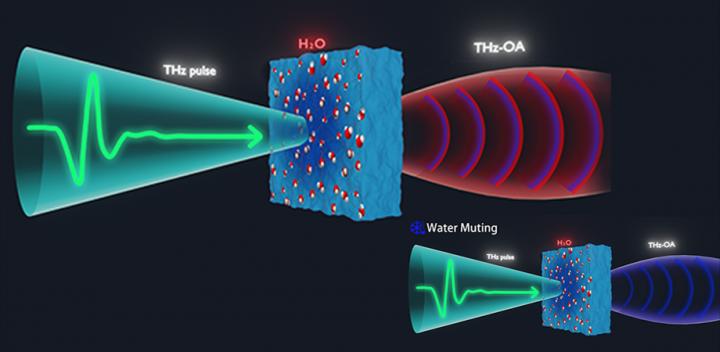The terahertz optoacoustic signal of water can be manipulated by adjusting temperature to allow detection of solutes, such as ions, with an order of magnitude greater sensitivity than terahertz time-domain spectroscopy

Credit: Li et al., doi 10.1117/1.AP.3.2.026003
Radiation at terahertz frequencies (wavelengths between 0.03 and 0.3 mm) can be used successfully to analyze the structural dynamics of water and biomolecules. But applying the technique to aqueous solutions and tissues remains challenging, since terahertz (THz) radiation is strongly absorbed by water. While this absorption enables certain analyses, such as the structure of water and its interactions with biological solutes, it limits the thickness of samples that can be analyzed, and it drowns out weaker signals from biomolecules of interest. Strong absorption of THz radiation in water has presented a bottleneck preventing THz radiation from revealing biophysical and biochemical processes deep within tissues.
To overcome these limitations, a research team led by Zhen Tian and Jiao Li at Tianjin University recently developed a method for analyzing water-rich samples via time-domain THz optoacoustics. As reported in Advanced Photonics, the novel system enables time-domain THz optoacoustic detection of water-rich samples, such as aqueous solutions and tissues. The optoacoustic signal of water can be dampened by altering temperature to enable the sensitive detection of other molecules of interest.
Water detection and dampening based on THz optoacoustics
The time-domain THz optoacoustics demonstrated is a breakthrough that enables precise and nondestructive detection of optoacoustic signals in water-rich samples over a 104-fold thickness, ranging from microns to centimeters (102-fold larger than traditional THz detection methods such as THz time-domain spectroscopy). The team successfully obtained the time-domain THz optoacoustic signals from water in different samples of agar-in-water phantoms, bio-tissues, and aqueous solutions with different solutes.
By adjusting the temperature to alter the THz optoacoustic signal of water, they improved the sensitivity with which it can be analyzed. Conversely, the signal of water can be reduced or even silenced.
The biomedical advantages are clear. According to the authors, “By manipulating THz optoacoustic signals of an aqueous background, we can achieve uniquely enhanced sensitivity for label-free quantification of ions, in concentrations reaching the levels in the human body.” The reported method achieves an order of magnitude greater sensitivity than commercially available THz spectroscopy systems.
Powerful tool for spectroscopy
The authors note that this new THz optoacoustic method can be extended to the study of other biological molecules and tissues, such as sugars, proteins, DNA, and RNA. Additional temperature and concentration parameters related to both THz absorption and ultrasonic propagation can be provided by time-domain THz optoacoustics, potentially contributing to studies of biological and chemical properties, such as the hydration number of ion solutions.
A powerful new tool for spectroscopy, THz optoacoustics opens up possibilities for imaging aqueous solutions and tissues to investigate molecular interactions and biochemical processes. Zhen Tian says, “We aim to inspire long-term research in THz spectroscopy and imaging in order to harness the biophysical, structural, and functional insights that cannot be obtained using radiation of other frequencies.”
Read the open access research article by Jiao Li et al., “Time-domain terahertz optoacoustics: manipulable water sensing and dampening,” Adv. Photon. 3(2), 026003 (2021), doi 10.1117/1.AP.3.2.026003.
###
Media Contact
Kevin Probasco
[email protected]
Original Source
https:/
Related Journal Article
http://dx.




